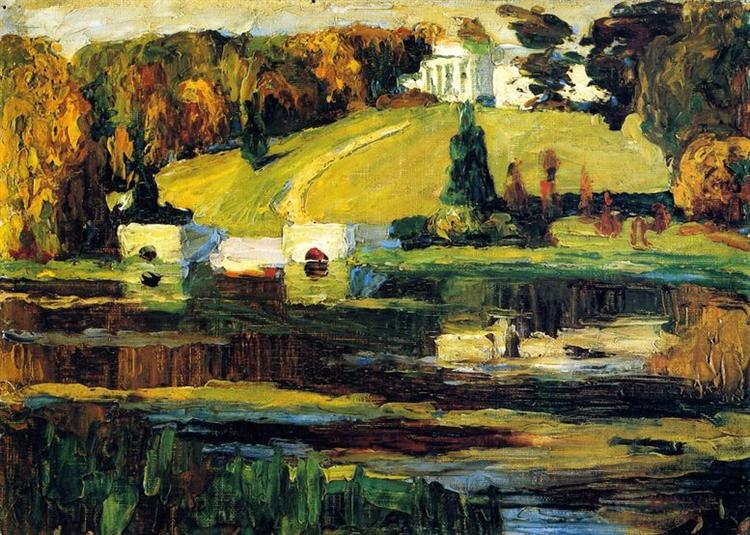Description
The work "Ojtyrka - Autumn - 1901", created by Wassily Kandinsky, represents a significant stage in the evolution of modern art and marks an early example of its transition towards abstraction. Kandinsky, one of the pioneers of expressionism and an influential art theoretical, uses in this piece a visual language that combines the observation of nature with a deeper emotional exploration.
At first glance, the painting reveals a composition in which the typical warm tones of autumn predominate, which evoke a nostalgic sensation of the station. The terrible and yellow colors are subtly intertwined with dark nuances, creating a depth effect that invites the viewer to immerse himself in a landscape that, although naturalistic in his representation, transcends the merely representative. The organic forms that are appreciated in the work seem to suggest a rural environment, possibly evoking the context of Okhtyrka, a city in Ukraine that lived several cultural influences throughout its history, including the artistic legacy that Kandinsky also carried with him.
Interestingly, the treatment of space in "autumn" is singular. Instead of adhering to the traditional perspective, Kandinsky opts for a flatter approach, in which the elements are distributed almost symbolicly, which reinforces the emotional quality of the landscape. The use of the horizon line, although implicit, helps to divide the composition, suggesting a wide and open sky that contrasts with the dense foliage of the trees, a recurring reason in his work that symbolizes the connection with the spiritual world and wisdom of nature.
There are no human characters in this work, which directs the viewer's gaze towards the interaction between the landscape and time, in this case, autumn. This choice reinforces the idea that Kandinsky was more interested in the perception of the environment through the emotion than in the figurative narrative. The absence of human figures allows the spectator to project their own experiences and feelings on the work, which contributes to its evocative power.
Kandinsky's chromatic language is another fundamental aspect of "autumn." Vibrant colors not only fulfill an aesthetic function, but also have a symbolic meaning. Yellow, for example, can be interpreted as a symbol of light and life, while the darkest tones suggest the arrival of winter and death, a contrast that underlines the duality of life itself. Kandinsky was known for his belief that color could evoke emotions and spiritual states, and this painting is a palpable manifestation of that ideal.
As for its place in the historical context, "Ojtyrka - Autumn" is in a period in which Kandinsky begins to distance himself in the realistic style towards an increasingly abstract language, which would culminate in his later work. This painting can be considered a bridge between the artistic traditions of the 19th century and the emerging avant -garde currents that would dominate the twentieth century.
The legacy of this work is, therefore, double: on the one hand, it captures a moment in the life of Kandinsky and art in general, and on the other, it establishes the basis for a new understanding of color and the form in expression Artistic "Ojtyrka - Autumn - 1901" It is not only a landscape, but a testimony of the ability of art to connect with deeper human emotions, reflecting on naturalness and the passage of time. Ultimately, Kandinsky invites the viewer to experience the landscape not only with the view, but with the heart and mind, an aspect that continues to resonate in contemporary art.
KUADROS ©, a famous paint on your wall.
Reproductions of paintings handmade oil, with the quality of professional artists and the distinctive seal of KUADROS ©.
Art reproduction service with satisfaction guarantee. If you are not completely satisfied with the replica of your painting, we refund your money 100%.

